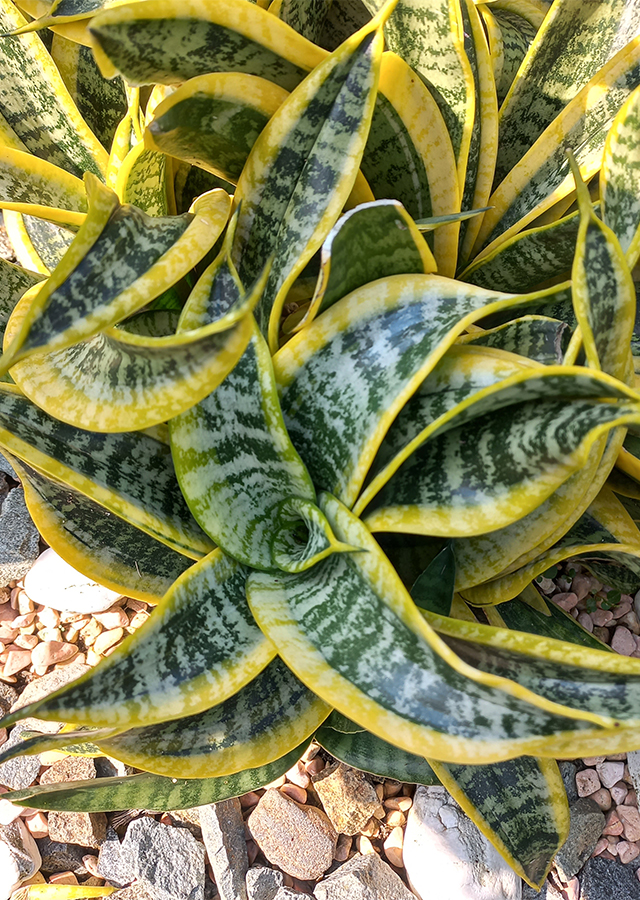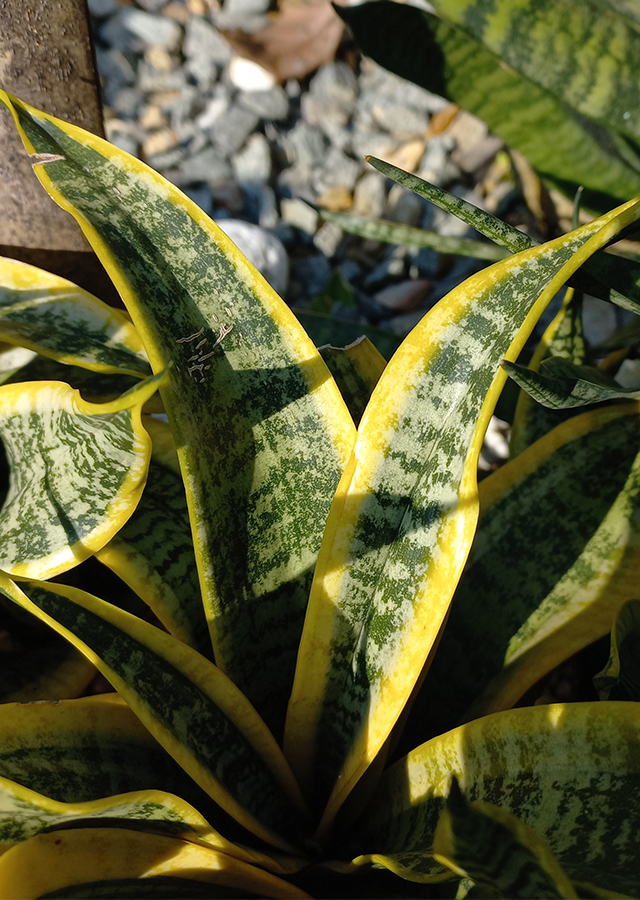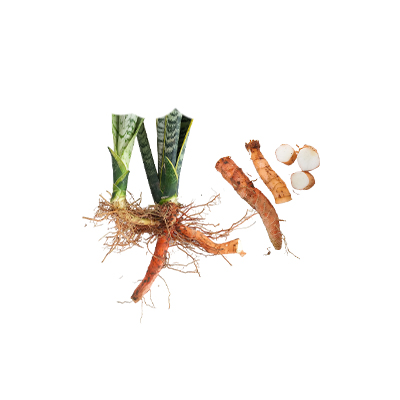Snake Plant
Dracaena trifasciata (Prain) Mabb.
Asparagaceae
Location in our garden
Principal



Synonym
Sansevieria trifasciata Prain
Sansevieria aureovariegata Mottet
Sansevieria laurentii De Wild.
Habitus
Succulent. A stemless, evergreen, succulent, perennial plant producing long, narrow, erect or slightly spreading sword-shaped leaves 30 - 120 cm long from a rhizomatous rootstock
Part Used
Leaves
Rhizome
Growing Requirements
Full Sunshine
Need Shade
Drought Resistant
Habitat
Forest
Coastal
Roadside
Shrublands
Grassland
Terrestrial
Overview
Dracaena trifasciata is native to tropical Africa. The plant is cultivated for its fibre in several tropical countries, it is also harvested from the wild for local medicinal use. It is commonly grown as an ornamental in tropical and subtropical regions, and as a pot plant in many other areas of the world. It is called a clean air plant as it helps improve air quality. NASA found back in the '70s that certain common houseplants could actually remove pollutants like formaldehyde, benzene, and ammonia from a room rather efficiently and further study supports this.
Vernacular Names
Waan hang suea (Thai), Pasa kilici (Turkey), Espada de Sao Jorge (Spanish), Tora no o (Japanese), Langue de belle-mere (French), Qian sui lan (Chinese), Espada de sao jorge (Brazil).
Agroecology
Found at elevations from 500 - 1,200 m. Prefers a well-drained soil in a sunny or partially shaded position and a pH between 6 and 7. Bright sunlight can lead to bleaching of leaf colour. Established plants are drought tolerant.
Morphology
- Roots - fibrous.
- Leaves - linear-oblanceolate, stiffly erect, 30-100 × 3 cm, the apex tapering to a stiff green point; the blades are transversely banded with contrasting green and whitish zones; margins are green.
- Flowers - solitary or in clusters of 2 or 3, pedicels up to 5 mm long; perianth tube 1 cm long or less, the linear lobes up to 2 cm long, white or greenish white.
- Fruits - subglobose to oblong-ellipsoid, 7-9 × 5-8 mm, bright orange.
Cultivation
Propagated by seeds, leaf cuttings, storage organ and division.
Chemical Constituents
Sapogenins, alkaloids, flavonoids, saponins, tannins, phenols, steroids, glycosides, triterpenes.
Traditional Medicinal Uses
- The plant is used to treat ringworm and fungal diseases.
- The leaf sap is applied directly on infected sores, cuts and grazes, it is also used to treat fungal and scabies infections.
- In China, decoction used for detoxification, as anti-inflammatory, and for treatment of sores and snake bites. Also used for boils, cough, bronchitis, traumatic injuries.
- In Sri Lanka, rhizomes used for coughs and colds; leaves used for snake bite.
Part Used
Reference Sources
- StuartXchange. Philippines Medicinal Plant. (2019). Dracaena trifasciata. http://www.stuartxchange.org/Tigre.html. 08-11-21.
- Cabi. Dracaena trifasciata. https://www.cabi.org/isc/datasheet/48196. 08-11-21.
- Fern, Ken. Useful Tropical Plants. (2014). Dracaena trifasciata. https://tropical.theferns.info/viewtropical.php?id=Sansevieria+trifasciata. 08-11-21.
- Flora & Fauna Web. Dracaena trifasciata. (2021). https://www.nparks.gov.sg/florafaunaweb/flora/2/4/2420. 08-11-21.
- North Carolina Extention Gardener Plant Tool Box. Dracaena trifasciata. https://plants.ces.ncsu.edu/plants/dracaena-trifasciata/. 08-11-21.

